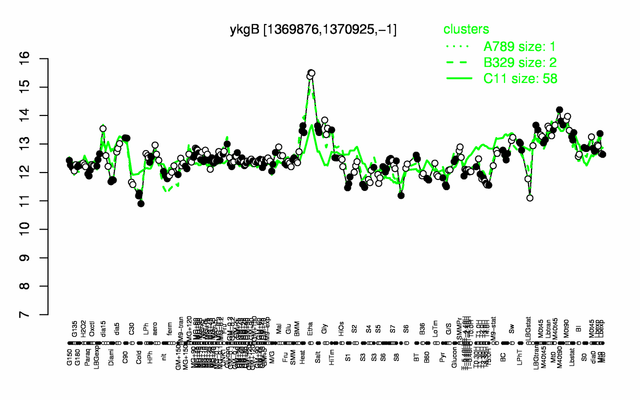Difference between revisions of "YkgB"
| Line 1: | Line 1: | ||
| − | + | * '''Description:''' putative 6-phosphogluconolactonase, general stress protein <br/><br/> | |
| − | |||
{| align="right" border="1" cellpadding="2" | {| align="right" border="1" cellpadding="2" | ||
|- | |- | ||
Revision as of 10:51, 8 August 2012
- Description: putative 6-phosphogluconolactonase, general stress protein
| Gene name | ykgB |
| Synonyms | |
| Essential | no |
| Product | putative 6-phosphogluconolactonase |
| Function | pentose phosphate pathway |
| Gene expression levels in SubtiExpress: ykgB | |
| MW, pI | 38 kDa, 5.154 |
| Gene length, protein length | 1047 bp, 349 aa |
| Immediate neighbours | ykfD, ykgA |
| Get the DNA and protein sequences (Barbe et al., 2009) | |
Genetic context 
This image was kindly provided by SubtiList
| |
Expression at a glance PubMed
| |
Contents
Categories containing this gene/protein
general stress proteins (controlled by SigB), carbon core metabolism
This gene is a member of the following regulons
The gene
Basic information
- Locus tag: BSU13010
Phenotypes of a mutant
Database entries
- DBTBS entry: [1]
- SubtiList entry: [2]
Additional information
The protein
Basic information/ Evolution
- Catalyzed reaction/ biological activity: the corresponding protein of E. coli is the 6-phosphogluconolactonase PubMed
- Protein family: cycloisomerase 2 family (according to Swiss-Prot)
- Paralogous protein(s):
Extended information on the protein
- Kinetic information:
- Domains:
- Modification:
- Cofactor(s):
- Effectors of protein activity:
Database entries
- Structure:
- UniProt: O34499
- KEGG entry: [3]
- E.C. number: 3.1.1.31
Additional information
Expression and regulation
- Regulatory mechanism:
- Additional information:
Biological materials
- Mutant:
- Expression vector:
- lacZ fusion:
- GFP fusion:
- two-hybrid system:
- Antibody: